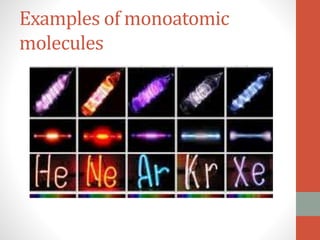Monoatomic molecules represent a fascinating domain of chemical study, characterized by their simplicity and unique properties. Unlike polyatomic molecules, which consist of two or more atoms bound together, monoatomic molecules are comprised of a single atom. This classification has profound implications in various fields of chemistry and physics, particularly in understanding elemental behavior, atomic interactions, and the fundamental building blocks of matter.
At the core of the discussion surrounding monoatomic molecules is the understanding of elemental gases. The noble gases, such as helium (He), neon (Ne), argon (Ar), krypton (Kr), xenon (Xe), and radon (Rn), are quintessential examples of monoatomic molecules. These gases exist in a single atomic state under standard conditions, resisting any propensity to bond with themselves or other elements due to their complete valence electron shells. This inertness makes them ideal candidates for numerous practical applications, including lighting, cryogenics, and even therapeutic uses in medicine.
The physical properties of monoatomic molecules contribute significantly to their practicality. For instance, their atomic masses and sizes vary across the periodic table, impacting their behavior in various states of matter. Helium, with its minimal atomic mass, serves as an excellent lifting gas in balloons and airships due to its low density. In contrast, argon, which is heavier, is often utilized in environments that require inert atmospheres, such as in the production of high-quality metals and in the preservation of sensitive materials. The unique thermal conductivity and low reactivity of these noble gases further elevate their status in industrial and scientific applications.
In addition to their elemental significance, monoatomic molecules provide profound insights into atomic theory and the nature of matter. When considering atomic structure, the monatomic gas behavior confirms essential principles of kinetic molecular theory. The rapid, random motion of these gases can be described through the ideal gas law (PV=nRT), illustrating how temperature, volume, and pressure are interrelated. This reflects not only the individual particles’ kinetic energy but also their unabated collision frequency, which enhances our comprehension of thermal dynamics.
Moreover, the study of monoatomic molecules lays a foundation for advanced research in quantum mechanics. Atomic orbitals and electron configurations play critical roles in determining the behavior and properties of elements. The simplification presented by monoatomic gases allows scientists to explore quantized energy levels without the complexities introduced by molecular bonds found in polyatomic substances. As a result, investigations into phenomena like atomic spectra become more straightforward and elucidative, providing clear illustrations of atomic transitions and energy emission processes.
However, the categorization of monoatomic molecules is not limited to noble gases alone. Metals, especially in their gaseous state at high temperatures—such as sodium (Na) and potassium (K)—can also exist as monoatomic molecules. This phenomenon occurs under specific conditions where thermal agitation overcomes the metallic bonding forces, resulting in a state where individual atoms can be observed. Such insights challenge existing paradigms within solid-state physics and offer new avenues for understanding metallic behavior in gaseous forms.
As one delves deeper into the implications of monoatomic molecules, it becomes evident that their study also crosses pathways with emerging technologies, particularly in nanotechnology and materials science. Monoatomic layers, such as graphene and other two-dimensional materials, present a unique intersection, where the properties of individual atoms contribute to emergent characteristics. The concept of manipulating materials on an atomic scale opens up possibilities for creating stronger, lighter, and more efficient structures, thereby enhancing electronic components, energy storage devices, and even biomedical applications.
Furthermore, the implications of monoatomic molecules extend beyond physical applications into environmental and planetary sciences. Understanding the behavior of these gases within atmospheric contexts is pivotal in climate studies, where their interactions with radiation impact temperature regulation and weather patterns. For instance, while noble gases are relatively inert, their presence as traces in the atmosphere can provide insights into various geochemical and biochemical processes. The gradual accumulation of noble gases in certain geological formations serves as an indicator of the earth’s age and can even assist in dating methods utilized in archaeology.
Despite their apparent simplicity, monoatomic molecules hold a wealth of knowledge waiting to be unpacked. Their study not only augments our understanding of elemental behavior but also bridges numerous scientific disciplines, enabling ongoing research into atomic interactions, materials development, and environmental dynamics. Understanding these monoatomic entities deepens appreciation for the intricate design of the universe, underscoring the pivotal role played by the simplest forms of matter in the grand tapestry of science and technology.
In conclusion, monoatomic molecules offer a rich landscape for exploration, from foundational atomic theory to practical applications in industry and technology. They exemplify how the simplest elements can yield profound insights and innovations, further motivating the scientific community to delve deeper into their enigmatic nature. Engaging with monoatomic molecules not only informs current scientific inquiries but also inspires future generations of researchers to explore the myriad possibilities that lie within the fundamental building blocks of existence.












